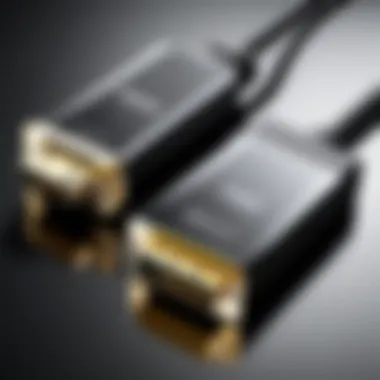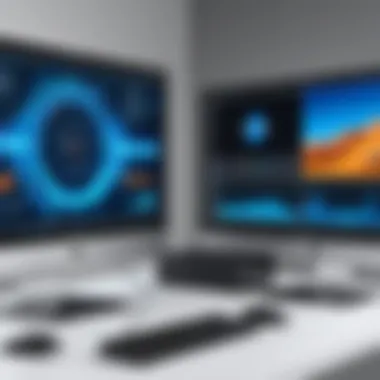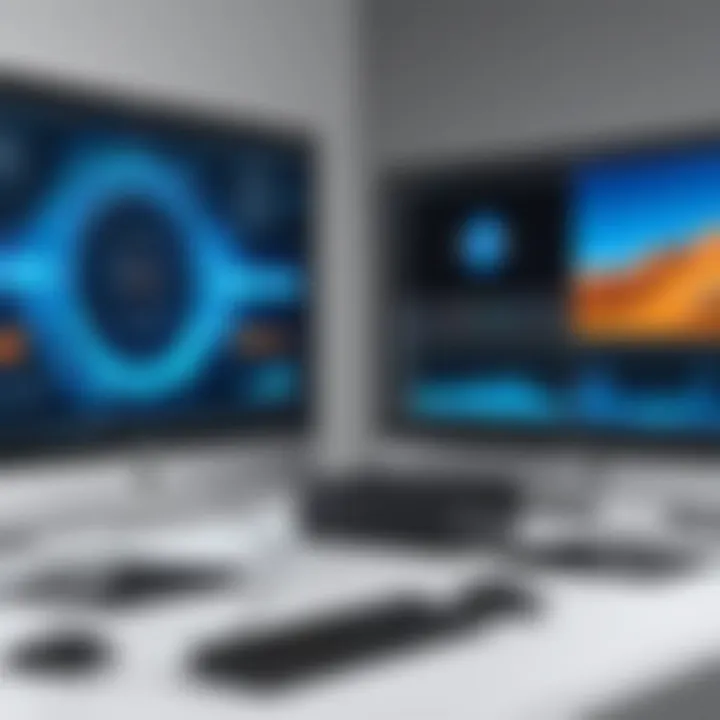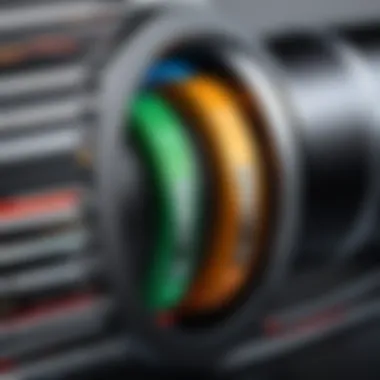Exploring Connection Methods for Dual Monitors


Intro
The integration of dual monitors into a computing environment has become a prevalent practice among IT professionals and tech enthusiasts alike. This setup not only enhances productivity but also optimizes workflow. With a multitude of connection methods available, understanding these options is crucial for effective implementation. Each method's compatibility and performance implications must be assessed to ensure an efficient setup. This article undertakes an in-depth exploration of various connection methods, guiding readers through both the practicalities and potential pitfalls to help achieve an optimal dual monitor experience.
Product Overview
Exploring the connection methods available for dual monitors begins with assessing the key interfaces involved. Different options cater to various needs.
Key Features
- HDMI: High-Definition Multimedia Interface is widely used for its ability to transmit both audio and video signals. It supports 4K resolution, making it ideal for high-definition displays.
- DisplayPort: Known for its versatility, DisplayPort can handle multiple monitors through a single cable with MST (Multi-Stream Transport) functionality.
- DVI: Digital Visual Interface is suitable for digital displays and can often be found in legacy systems. It lacks support for audio transmission.
- VGA: Video Graphics Array, although considered outdated, is sometimes utilized due to its presence in older monitors and systems. It transmits analog signals.
- USB-C: This modern interface not only supports video transmission but also power delivery, making it useful for laptops and mobile devices.
Technical Specifications
Each of these interfaces has its unique specifications which affect their performance:
- HDMI: Supports bandwidth up to 48 Gbps with a maximum resolution of 10K at 30Hz.
- DisplayPort: Offers bandwidth of up to 32.4 Gbps, supporting 8K resolution at 60Hz.
- DVI: Provides a maximum resolution of 1920x1200 at 60Hz for single-link connections, while dual-link can reach 2560x1600.
- VGA: Typically supports a maximum resolution of 2048x1536.
- USB-C: Capable of supporting video streams over Thunderbolt 3, allowing for high resolutions exceeding 4K in some cases.
Performance Analysis
To ensure a successful dual monitor setup, evaluating the performance implications of each connection method becomes essential.
Benchmark Test Results
Testing various setups reveals that DisplayPort tends to outperform other methods in bandwidth capacity, making it favorable for designers or gamers requiring high refresh rates and responsive visuals. HDMI has proven to be reliable for most users looking for straightforward audio-video transmission.
Real-World Usage Scenarios
In practical terms, the choice often depends on factors such as existing hardware, intended use, and personal preferences. Common scenarios include:
- Office Work: Utilizing HDMI or DVI is often suitable for standard tasks like spreadsheets or document editing.
- Graphic Design: Professionals in creative fields benefit from DisplayPort’s higher bandwidth, suitable for intensive graphical work.
- Gaming: Gamers frequently prefer HDMI for its support of high refresh rates and resolution.
Preface to Dual Monitor Connectivity
In the realm of modern computing, the ability to connect dual monitors is a vital aspect that enhances productivity, particularly for IT professionals and tech enthusiasts. Dual monitor setups offer a more expansive workspace, allowing users to multitask efficiently and improving overall workflow. By integrating two displays, individuals can view multiple applications side by side, which reduces the time spent switching between tabs or windows, ultimately leading to more streamlined operations.
Key benefits of dual monitors include improved multitasking capabilities and a reduction in distractions. For instance, software developers can code on one screen while running tests on the second. Similarly, data analysts can monitor datasets while creating reports, enhancing their ability to interpret data in real time.
Considerations about connectivity include understanding the types of ports available, the compatibility between monitors and graphics cards, and the potential need for adapters or additional hardware. A thorough appraisal of these aspects ensures a seamless connection and optimal performance. Moreover, it is essential to stay informed about the latest standards and technologies emerging in display connections, as these developments can significantly affect setup efficiency and performance.
"Adopting dual monitors in your workflow not only optimizes task completion but also elevates the quality of your output."
Understanding Display Interfaces
Understanding the various display interfaces is critical for effectively connecting dual monitors. Each interface has its unique characteristics, which influence compatibility, performance, and overall usability in a computing environment. As technology evolves, the variety of display connections available can be daunting. IT professionals and tech enthusiasts must grasp the nuances of these interfaces, ensuring that their setups are not only functional but also capable of meeting their performance needs.
Knowledge of display interfaces goes beyond mere connection; it involves comprehension of bandwidth, resolution support, and refresh rates. For instance, some connections are better suited for high-performance tasks, such as gaming or video editing, due to their higher data transfer rates. Others may provide legacy support but fall short of modern requirements. Thus, understanding these interfaces can help users optimize their dual-monitor setups in ways that enhance productivity and efficiency.
HDMI: A Versatile Option
HDMI, or High-Definition Multimedia Interface, is one of the most commonly used display connections. Its versatility is largely due to its ability to transmit both video and audio signals through a single cable. This feature simplifies the cabling process and reduces clutter, making HDMI an ideal choice for home entertainment systems, gaming setups, and professional workstations.
HDMI supports 4K resolution and various refresh rates, making it a competitive option for many users. It is compatible with a wide range of devices, from monitors to televisions and laptops. However, users must consider the HDMI version in use, as older versions may not support the latest standards.
Key points about HDMI:
- Easy to use with a single cable setup
- Supports both audio and video
- Versatile compatibility with many devices
DisplayPort: High Performance and Flexibility
DisplayPort offers more than just a connection option. It excels in performance, capable of supporting multiple monitors through a single cable using Multi-Stream Transport (MST). This feature allows users to daisy chain several monitors, which is beneficial for complex workstation setups.


Furthermore, DisplayPort supports higher resolutions and refresh rates compared to HDMI, making it a preferred option for high-end applications like PC gaming and professional graphics work. It allows users to take full advantage of their hardware capabilities.
Important features of DisplayPort include:
- High bandwidth capability, supporting 8K displays
- Ability to daisy chain multiple monitors
- Adaptive Sync technology for smoother gaming
DVI: Legacy Support in a Modern World
DVI, or Digital Visual Interface, was once a standard for high-quality video output. While it has become somewhat outdated due to the rise of HDMI and DisplayPort, it still serves an important role in legacy systems. Many older monitors utilize DVI connections, making it relevant for users who work with older hardware.
This interface can support digital signals and, depending on the configuration, analog signals as well. Users should be aware that DVI does not carry audio signals, which can be a limitation in setups where audio integration is vital.
Advantages of DVI include:
- Compatibility with older technology
- Good video quality for digital signals
- Variation of connections such as DVI-I and DVI-D for flexibility
VGA: An Antiquated Connection?
VGA, or Video Graphics Array, is often viewed as an outdated connection method. Introduced in the 1980s, its analog nature limits compatibility with modern digital displays. VGA does not support the high resolutions offered by newer connections, which may lead to inferior image quality.
Despite its age, VGA remains prevalent in some legacy systems and environments. It may also be necessary for certain projectors or older monitors. Users should weigh the advantages of using VGA against the limitations in performance and image quality.
Key considerations for VGA include:
- Limited to analog signals
- Lower maximum resolutions compared to modern options
- Compatibility primarily with older devices
Understanding these display interfaces is crucial for optimizing dual monitor connections. Each method has its unique strengths and weaknesses, which will inform decisions based on specific use cases and existing hardware.
Evaluating Graphics Card Requirements
Evaluating graphics card requirements is crucial for anyone setting up a dual monitor setup. The graphics card serves as the linchpin in this arrangement, determining how well the monitors will perform together. This section will provide insights into how integrated and dedicated graphics cards differ in functionalities, alongside tips on handling situations where ports may be missing. Understanding these aspects can enhance both efficiency and productivity for IT professionals and tech enthusiasts alike.
Integrated vs. Dedicated Graphics Cards
Integrated graphics cards are built into the motherboard, sharing system memory. They are often sufficient for basic tasks such as web browsing and document editing. However, in the context of dual monitors, integrated graphics may struggle with high-resolution displays or demanding applications like video editing or gaming. For basic dual monitor setups, integrated options may suffice, but one must consider the potential limits of performance when multiple tasks are executed.
On the other hand, dedicated graphics cards, such as those made by NVIDIA and AMD, feature their own memory and processing power. This separation allows them to handle multiple displays with greater efficiency, especially when running resource-intensive applications. A dedicated card can provide smoother performance, higher resolution support, and more options for connection types, making them ideal for a seamless dual monitor experience.
In summary, if your work involves graphic-intensive applications or requires richer display qualities, opting for a dedicated graphics card is advisable. Here are a few pointers to assist in your choice:
- Performance Needs: Assess what applications you run and determine if they require more graphical power.
- Compatibility: Ensure your card supports the desired output configurations for dual monitors.
- Future Upgrades: Consider how your graphics card will fit into future setups as demands grow.
Missing Ports and What to Do
Sometimes, the desired connections for dual monitors may not be present. Missing ports can lead to confusion and frustration. Here are some strategies for addressing this issue:
- Adapters: Often, adapters can bridge the gap between available ports and the desired connection types. For example, an HDMI to DisplayPort adapter can allow an HDMI output from a computer to connect to a DisplayPort monitor.
- Daisy Chaining: If using DisplayPort technology, daisy chaining can be a solution. This technique allows multiple monitors to connect in series, reducing the need for multiple ports.
- Upgrading the Card: If the existing graphics card does not support enough outputs, upgrading to a more capable unit that offers the necessary connections can be an option. This upgrade can be an investment that boosts overall performance.
"Choosing the right graphics card is essential for optimizing dual monitor setups. Ensure compatibility and performance needs align with your specific tasks."
Connection Techniques for Dual Monitors
Establishing proper connection techniques for dual monitors is essential in today’s technologically advanced environment. These techniques not only determine how well the displays function together but also impact overall productivity. Selecting the right connection method may enhance visual performance, reduce lag, and allow for seamless multitasking. Each method has its unique benefits and compatibility considerations which can cater to different setups and needs.
Direct Connection via Ports
Directly connecting dual monitors through dedicated ports is often the most straightforward method. Almost all modern graphics cards come equipped with multiple ports for various display technologies. Common options include HDMI, DisplayPort, and DVI. The benefits of direct connection include:
- Simplicity: Fewer cables and adapters make for easier installations and less chance of errors.
- Stability: Direct connections minimize latency issues, providing real-time display responses.
- Quality: They often support higher resolutions and refresh rates effectively.
When connecting through these ports, it is crucial to check whether both monitors support the selected interface. For example, if using HDMI, ensure that both monitors have at least one HDMI port. This makes setup hassle-free.


Connection Through Adapters
In scenarios where direct connection is inadequate due to port mismatches, adapters become invaluable. Adapters allow for converting one type of connection to another. Some popular types include HDMI to DisplayPort, DVI to HDMI, etc. While adapters introduce a layer of complexity, they provide flexibility for extensive display setups. Key considerations include:
- Compatibility: Not all adapters support features like 4K resolution or high refresh rates. Verify compatibility beforehand.
- Signal Quality: The use of poorly built adapters can lead to degraded signal quality. Investing in reputable brands is advisable.
- Power Requirements: Some active adapters may need external power to function correctly. Make sure to have the necessary equipment available.
In summary, adapters offer solutions to connection issues, enhancing the flexibility of dual monitor setups without needing to purchase new hardware.
Using Daisy Chaining for Multiple Displays
Daisy chaining allows users to connect multiple monitors in a series. This method is generally achieved through DisplayPort Multi-Stream Transport (MST). It is particularly advantageous for setups needing more than two monitors. Important benefits include:
- Cable Management: Fewer cables are needed, as one monitor connects to the next.
- Simplified Setups: It reduces the cluttered look of multiple cables running from each monitor to the computer.
- Cost-Effective: Instead of buying multiple graphics cards, users can utilize one output to run several monitors.
However, daisy chaining does require certain prerequisites:
- MST Support: Both the graphics card and monitors must support MST features.
- Limited Bandwidth: The total display resolution can be limited by the bandwidth of the original connection. It is essential to plan your setup according to your resolution needs.
Overall, daisy chaining can be a powerful and efficient way to manage multiple displays, provided the necessary conditions are met.
Software Considerations for Dual Monitors
When setting up dual monitors, the role of software is often overlooked. Yet, it serves as the backbone that allows users to harness the full potential of their extended workspace. In an environment where productivity is paramount, understanding the software side is crucial for IT professionals and tech enthusiasts. Proper software considerations ensure that the connection methods used can optimize performance, enhance user experience, and avoid common pitfalls during configuration.
Operating System Support
The choice of operating system can significantly impact how dual monitors function. Most modern operating systems, such as Windows, macOS, and various Linux distributions, offer native support for multiple displays. However, the level of support varies, affecting everything from display resolution settings to performance optimization.
For Windows users, features like Snap assist and virtual desktops can enhance multitasking. Users can easily rearrange windows and manage tasks more effectively, thanks to the built-in software. Likewise, macOS provides excellent support with features like Mission Control, allowing quick transitions between different applications spread across monitors.
On the other hand, Linux users may find more variability in support depending on the desktop environment. Not all Linux distributions handle dual monitors equally, which can create issues with configuration. Familiarity with the specific environment being used, such as GNOME or KDE, can lead to better monitoring management.
It’s essential to check compatibility details before setting up dual monitors with any operating system. Not all versions will exhibit the same capability regarding multiple displays.
Driver Updates and Configuration
Driver updates play a pivotal role in ensuring that dual monitor setups perform optimally. Graphics drivers are responsible for managing how the operating system communicates with the graphics hardware. If the drivers are outdated, issues can arise, such as display flickering, resolutions not displaying correctly, or even the inability to detect a connected monitor.
Regularly updating drivers can alleviate these problems. Manufacturers like NVIDIA and AMD often release updates that enhance performance and fix bugs related to multi-monitor configurations. Users should visit the respective websites to download and install the latest drivers.
Once drivers are up to date, proper configuration is essential. Each operating system provides settings for configuring displays. For Windows, the display settings offer options to change the primary monitor, adjust resolutions, and manage display orientations. Users should take the time to personalize these settings. On macOS, similar adjustments can be made through system preferences.
Blockquote:
"Keeping your graphics drivers updated is not just a recommendation but a necessity for a seamless dual monitor experience."
Summary
To summarize, software considerations are integral to a successful dual monitor setup. Operating system support determines basic functionality, while up-to-date drivers enhance performance and avoid common issues. For IT professionals, prioritizing these aspects leads to a more efficient workflow and ultimately improves productivity in various tasks.
Best Practices for Dual Monitor Setup
Setting up dual monitors can significantly enhance productivity and improve workflows in any IT environment. However, the effectiveness of this setup depends on adhering to certain best practices. These practices help ensure that the monitors function optimally and provide a seamless experience for the user. Key elements to consider include the physical arrangement of the displays, the resolution and refresh rates of each monitor, and the software configuration that supports such a setup.
Optimal Display Arrangement
The physical placement of monitors is crucial for efficient usage. When arranging your dual monitors, aim for ergonomic convenience. Ideally, the displays should be at eye level to reduce strain on the neck and eyes. This can be achieved by adjusting the height of the monitors or using monitor stands. Additionally, the monitors should be positioned at a slight angle towards the user. This minimizes the need to turn the head excessively, which can lead to discomfort over long periods.
Consider having the primary monitor directly in front of you, while the secondary monitor is positioned to the side. This setup allows for quick glances between the two screens without losing focus on the primary task. Moreover, the optimal display arrangement may differ based on the type of work performed. For example, graphic designers might prefer a wider angle for color accuracy, while software developers may choose a direct alignment for code review.
- Keep the space tidy to avoid distractions.
- Utilize cable management solutions to enhance aesthetics and safety.
- Ensure adequate lighting to reduce glare on screens.


Resolution and Refresh Rate Settings
Resolutions and refresh rates play a significant role in how users interact with dual monitors. Both monitors should ideally support the same resolution for a consistent viewing experience. When setting up, it is essential to check the display settings in your operating system to ensure that each monitor's resolution matches its native resolution, providing clarity and detail where required.
Refresh rates should also be taken into account. A higher refresh rate typically results in smoother motion on the screen. For example, if one monitor supports 60Hz and the other one supports 144Hz, the latter will outperform regarding fluidity. Ensuring both monitors have compatible refresh rates prevents lag and synchronization issues.
"Proper setup of dual monitors is not just a luxury but can significantly boost productivity for IT professionals and tech enthusiasts."
Troubleshooting Connection Issues
In every dual monitor setup, connection issues can arise, undermining productivity and creating frustration. Understanding troubleshooting methods is crucial as it allows users to identify and fix problems swiftly. This section highlights common problems, solutions, and diagnostic tools, crucial for maintaining a seamless dual monitor experience. The importance of being equipped with troubleshooting skills cannot be overstated, as these can save time and prevent potential disruptions in workflows.
Common Problems and Solutions
Several issues may be encountered when connecting dual monitors. Awareness of these can facilitate rapid resolutions.
- No Signal: When one or both monitors display a "no signal" message, it can point to several issues, such as improper cable connections or incorrect input settings. First, ensure that cables are securely connected at both the monitor and the computer. Check the source input on the monitor. Sometimes, the correct port is not automatically selected.
- Display Flickering: Flickering can be caused by several factors ranging from refresh rate settings to faulty cables. Adjusting the refresh rate to match the monitor’s specifications often resolves this issue. Make sure to use high-quality cables to minimize disruptions.
- Screen Resolution Issues: Monitors may not display content correctly due to incompatible resolution settings. Ensure that the computer's display settings are configured to reflect the capabilities of each monitor. You may have to adjust individual settings for each monitor in the operating system.
- Color Mismatches: Problems with color output can result from incorrect color settings or cable issues. Ensure that the color profile is set correctly in the display settings. Test different cables to rule out hardware faults.
In summary, a systematic approach to troubleshooting can typically resolve most common issues encountered in dual monitor setups.
Using Diagnostic Tools
Utilizing diagnostic tools can significantly ease the process of troubleshooting connection issues. These tools help identify the root causes of problems more efficiently.
- Windows Display Troubleshooter: For Windows users, the built-in Display Troubleshooter can automatically detect and fix issues related to multiple displays. Users can access this tool by navigating to Settings > System > Display > Troubleshoot.
- Third-party Software: Various third-party applications provide more in-depth analyses of connection issues. Tools like HWMonitor or DisplayFusion can analyze hardware performance and display configurations, offering insights into potential problems.
- Cable Tester: A cable tester is a useful tool for assessing whether the cabling is functional. This device can quickly determine if cables are intact or need replacement.
- Driver Update Utilities: Ensuring your graphics card drivers are up to date can prevent many issues related to dual monitors. Utilitarian software that checks for driver updates can simplify this process.
Utilizing these diagnostic tools allows technicians and enthusiasts to maintain their setups efficiently, promoting workflow rather than hindering it.
Ensuring optimal functionality in a dual monitor setup is about being prepared for connection issues and having efficient troubleshooting methods at hand.
By understanding common problems and employing appropriate tools, you can minimize downtime and enhance your dual monitor experience.
Future Trends in Monitor Technology
The landscape of monitor technology is continuously evolving. With the increasing demand for high-resolution displays and enhanced connectivity options, it is vital to understand the upcoming trends that will shape how dual monitors will function in various IT workflows. This section highlights important advancements that can impact productivity, user experience, and compatibility.
Emerging Connection Standards
As technology progresses, new connection standards are emerging that aim to improve performance and ease of use. These advancements often come with several benefits:
- USB-C: This connection standard is gaining popularity due to its versatility. It can carry both video and power, thus reducing cable clutter. USB-C is suitable for many devices, making it an ideal choice for dual monitor setups.
- Thunderbolt: This connection offers high compatibility and data transfer rates. Thunderbolt 3 and 4 are noteworthy standards that support daisy chaining multiple monitors, enabling robust setups without sacrificing performance.
- DisplayPort 2.0: The latest version of DisplayPort is set to debut with significant improvements. It promises to support higher resolutions and refresh rates, which is crucial for high-end graphics applications.
These connection standards not only enhance performance but also facilitate a more seamless integration of dual monitors in today’s work environments.
Potential Impacts on Dual Monitor Use
The implications of these emerging technologies are profound. As standards evolve, IT professionals and tech enthusiasts must consider several factors:
- Increased Resolution Support: Higher standards will allow users to utilize high-refresh displays without compromising on quality. This may lead to better user experiences in graphic design, gaming, and data analysis.
- Simplified Connectivity: With more compact and versatile connections such as USB-C and Thunderbolt, users will enjoy simplified setups. This leads to less frustration during configurations and troubleshooting.
- Future-proofing Investment: Staying informed about trends allows users to make educated decisions when purchasing new hardware. Investing in modern connections ensures compatibility with future devices and setups.
"Understanding emerging connections can directly enhance the efficiency within an IT environment. The right choices can save time and resources."
Considering these trends is paramount for any professional relying on dual monitors. Adapting to new standards may offer significant benefits, making it easier to foster more efficient work habits. By acknowledging the future of monitor technology, users can maximize their productivity and ensure smooth operations in an ever-evolving tech landscape.
Closure
In essence, the benefits of a dual monitor setup are clear. It enables better multitasking capabilities, which is essential for professionals working on complex tasks or dealing with large datasets. Furthermore, knowing the different connection methods can guide users in optimizing their hardware to meet unique demands. The implications of emerging trends in monitor technology signal the need for ongoing education and adaptability.
Key considerations when concluding this exploration include:
- Compatibility of Devices: Ensuring that all components are compatible is vital for a successful setup.
- Technology Evolution: Keeping abreast of emerging standards is essential for future-proofing your equipment.
- Visual Ergonomics: Adapting arrangements to foster comfort and efficiency is important for long-term use.
Understanding the themes discussed provides IT professionals and tech enthusiasts with the knowledge required to harness the full potential of dual monitoring systems. As technology continues to evolve, staying informed about connection methods will undoubtedly enhance productivity and optimize workflows.
Summary of Key Points
- Diverse Connection Options: HDMI, DisplayPort, DVI, and VGA are pivotal in establishing connections. Each serves specific performance and compatibility purposes.
- Graphics Card Considerations: Differentiating between integrated and dedicated graphics cards impacts overall performance in a dual monitor setup.
- Adaptability: Employing adapters and daisy chaining can often bridge gaps in port availability.
- Software Influence: Proper software configuration, regular driver updates, and operating system support are necessary for managing multi-display environments effectively.
- Future Trends: Technologies are continually evolving. Familiarity with new standards will allow for better planning and execution.
In summary, harnessing the potential of dual monitors through the right connections can streamline tasks and elevate productivity. Leveraging these insights, users can make informed decisions about their setup, positioning themselves advantageously in their work environments.



